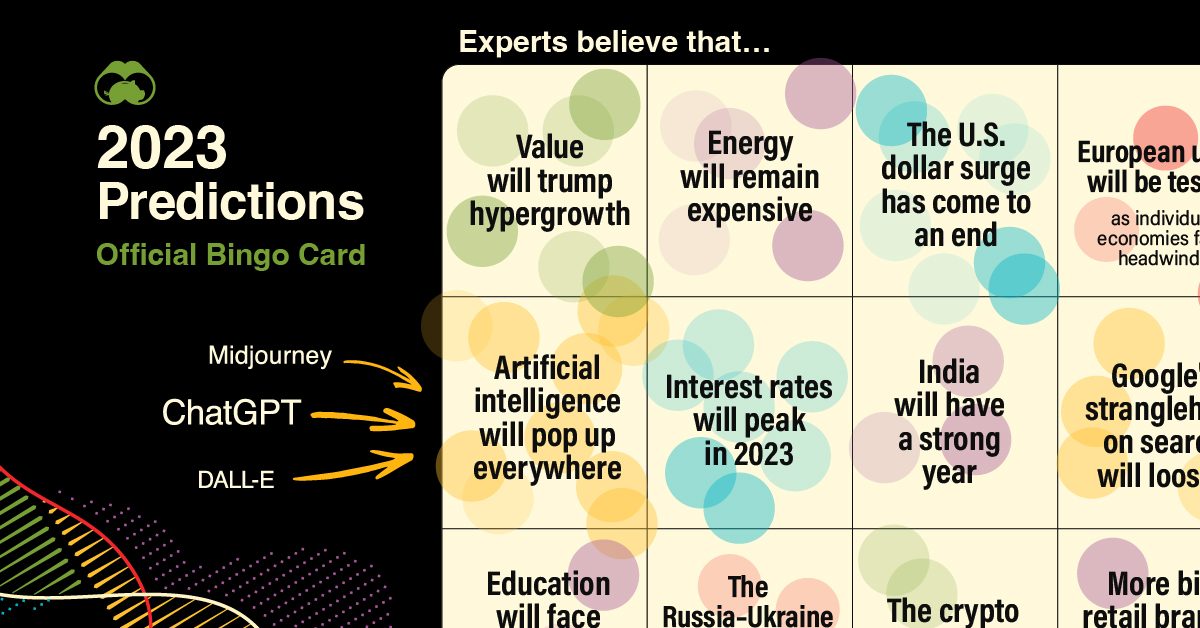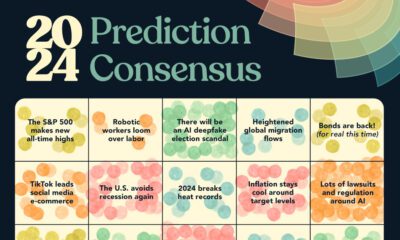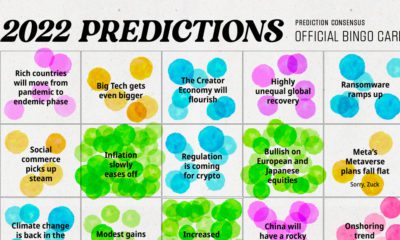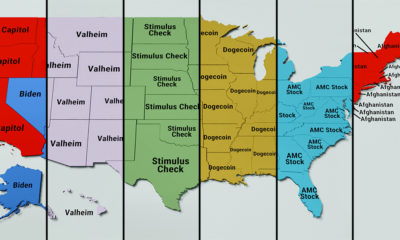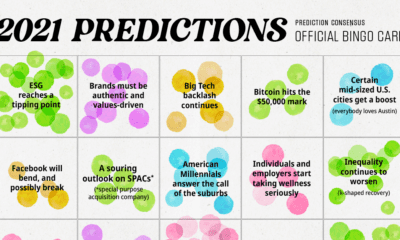Technology
Prediction Consensus: What the Experts See Coming in 2023
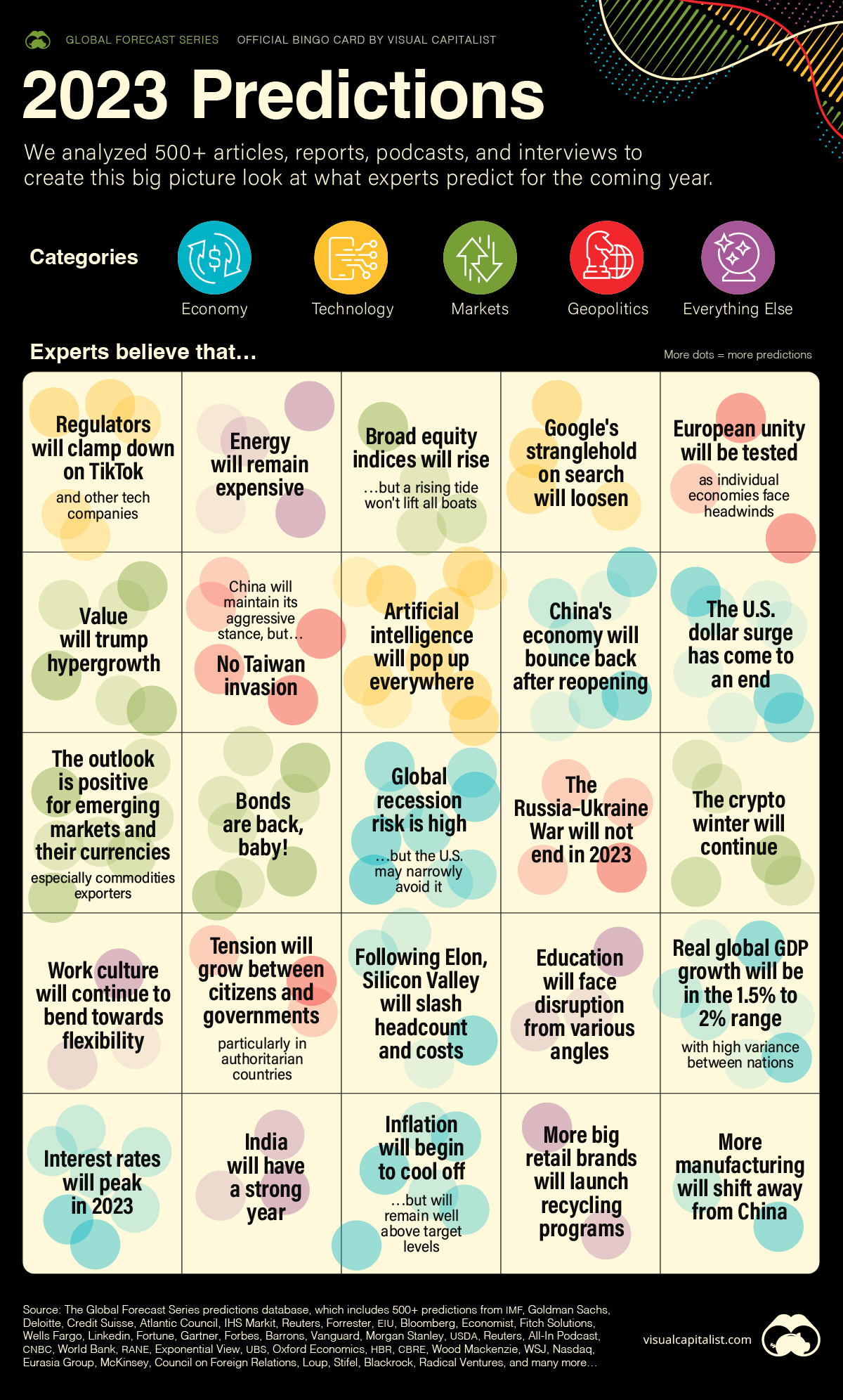
Prediction Consensus: What the Experts See Coming in 2023
In this, our fourth year of Prediction Consensus (now part of our more comprehensive 2023 Global Forecast Series), we’ve learned a few things about the universe of predictions, experts, outlooks, and forecasts.
- Experts are reasonably good at predicting the future one year out, though they are also in a strong position to help shape the future through their influential thought leadership and actions.
- Situations can and will flare up in unexpected ways, which can have knock-on effects on the whole system (e.g. COVID-19, Ukraine invasion).
- Experts are just as susceptible to hype as the rest of us, as evidenced by the glut of Web3 predictions in 2022 and AI predictions this year.
Of course, we’re susceptible to hype as well, which is why we asked ChatGPT to write the intro to this article:
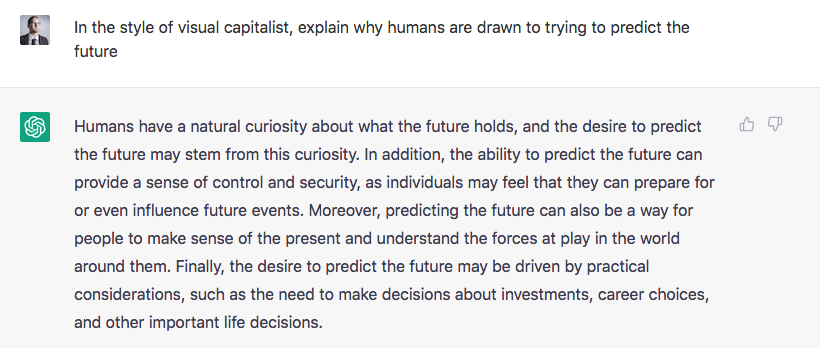
Not bad. But, simple curiosity aside, it’s the practical considerations we’ll focus on today. This article serves as an overview of how experts think the markets will move, how trends will develop, and which risks and opportunities to watch over the coming 12 months.
Let’s gaze into the crystal ball.
The Economic Vibe Check
First, we’ll look at some big picture themes, and how experts see them playing out over 2023.
Inflation: This was the top economic story of last year, so it’s a natural starting place. Many of the expert opinions in this year’s database (now at 500+ predictions) are pointing to inflation easing off as the year progresses*. On the downside, few predict that inflation will drop back down to the 2% range that Fed policymakers favor.
GDP: Forecasters have been revising their economic projections downward in recent weeks. The latest was World Bank, which now sees global growth declining to 1.7% in 2023, down from 3% just six months ago. Most of the predictions in our database see global economic growth in the range of 1.5% to 2%.
Recession: As 2022 came to a close, the broad sentiment among experts in the financial industry is that recession is all but inevitable in developed markets this year. As dawn breaks in 2023, a few analysts now feel that the U.S.—and possibly Europe—could narrowly avoid recession.
Markets: Experts on Wall Street and beyond are cautiously optimistic about equities, and after the worst year on record for bonds in 2022, most analysts are declaring that “Bonds are back”.
*Interestingly, this was also last year’s prediction, but the scale of Russia’s invasion of Ukraine was a curve ball that caught many experts off guard.
AI is Eating the World
Jobs being displaced by automation is far from a new theme, but given the exponential improvements in AI in recent years, the risk to entire industries feels more existential today.
As an example, let’s consider art and design. One of the ways many illustrators and artists earn a living is through commissions—essentially being hired and paid to create a specific piece of art in their style.
Today though, free, powerful AI tools, such as Midjourney, allow users to generate high-quality art in an infinite number of styles with just a few clicks. Real art will never truly go out of style, and accomplished artists will always attract an audience, but this one example shows how quickly technology can disrupt an industry. (Artists can take solace in the fact that AI is still comically bad at rendering hands.)
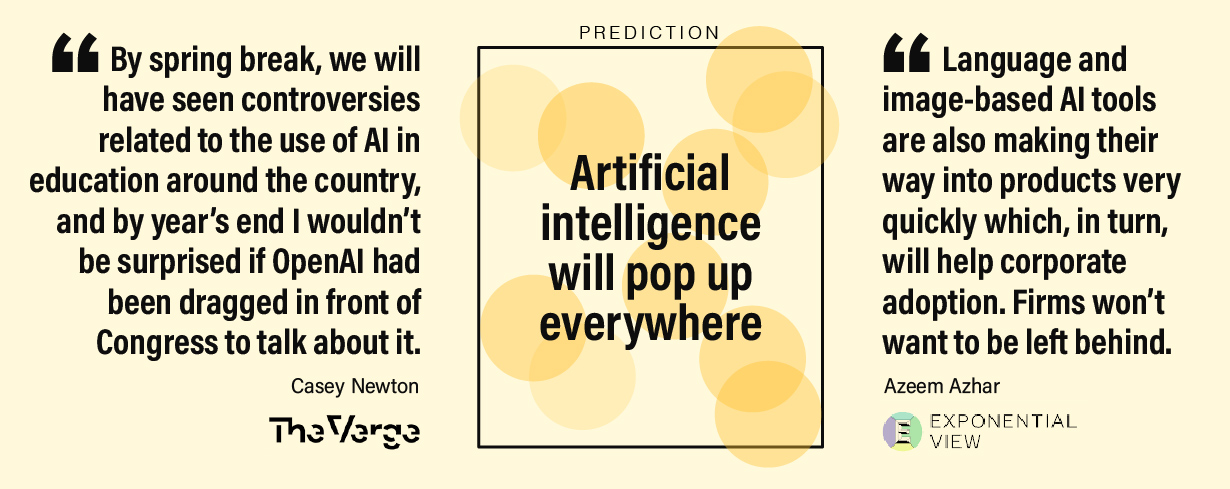
Of course, there are obvious positive aspects to this technological advancement as well. Generative AI tools are useful for generating ideas and mock-ups, and even functional snippets of code. AI systems like AlphaFold unlock a world of possibilities in scientific domains.
From the hundreds of predictions we evaluated, it’s clear that experts view AI as a major catalyst this year. AI start-ups are forcing Big Tech to innovate faster, and employees are finding new ways to use AI-powered tools to increase productivity.
Experts predict that AI will impact peoples’ lives in a much more visible and tangible way in 2023 than in past years.
The China Factor
As world’s second largest economy and linchpin of global trade, events in China have a major impact on the world economy.
Xi Jinping’s reversal of Zero-COVID restrictions should drastically change the trajectory of the country’s economy. For one, reopening will unleash a flood of household spending and consumption.
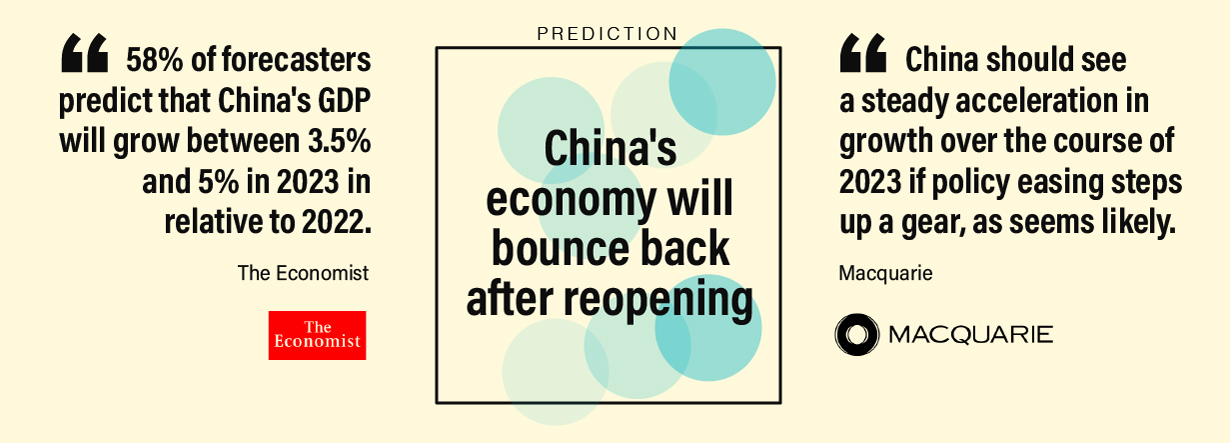
China’s reopening will also impact other economies as well. For example, the resumption of travel will be a boon to destinations favored by Chinese vacationers. Economically, Hong Kong stands to benefit immensely—its GDP could jump upwards of 8% after reopening is complete. Emerging market commodity exporters could see a lift as well, though inflation could be reinvigorated as a result.
In the U.S., a storm is brewing over the extremely popular video app, TikTok. Many experts predict that regulators will either ban the app altogether in 2023, or force the sale of the company to an American entity. Regardless how that situation plays out, it underscores the souring relationship between the U.S. and China. The rivalry will continue to have ripple effects on the global markets throughout the year.
Energy
Energy was the S&P 500’s top performing sector two years in a row, and many experts feel that more growth is on the horizon.
The global system that supplies us with energy is breathtakingly complex, with a lot of unpredictable factors at play. Of all factors, conflict can create the most volatility, and 2023 has a number of geopolitical risks that could impact energy supplies. First, Europe will continue to diversify its energy imports away from Russia. Recently, liquefied natural gas from the U.S. has helped fill gaps.
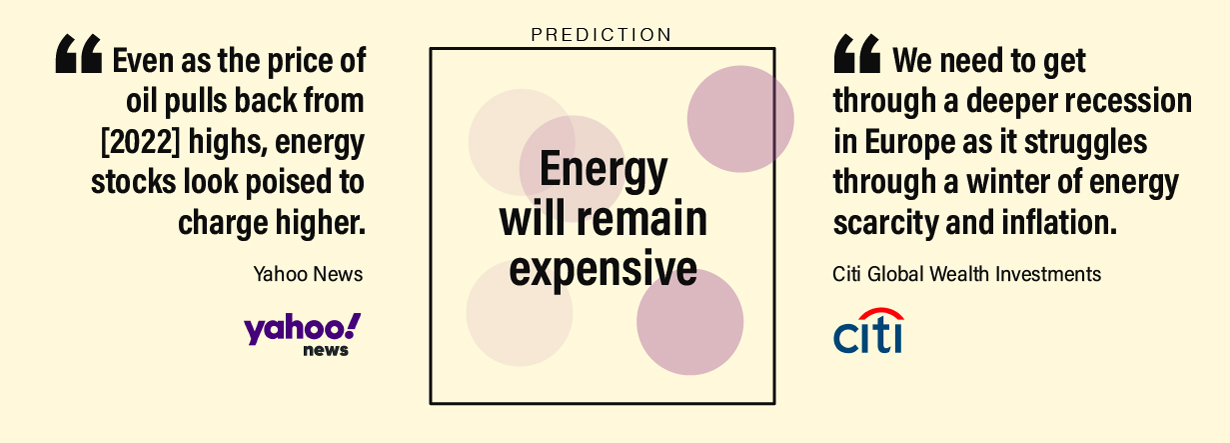
Next, Iran could be a flashpoint in the Middle East this year. A brewing conflict in the region could cause instability, which will have knock-on effects on the energy industry—particularly in the event of attacks on oil and gas infrastructure.
Here are a few other factors to consider this coming year:
- The U.S. Energy Department will aim to replenish its Strategic Petroleum Reserve
- Easing of U.S. sanctions on Venezuela could lay the ground work for increased oil production
- In post-Zero-COVID China, economic activity will increase, pushing up demand
- In the UK, the energy price guarantee will rise in April, meaning higher energy bills for households
The Elon Playbook
After a lull in December (nobody wants to be the company that fires people during the holiday season) tech and tech-adjacent companies have resumed their zealous slashing of headcounts.
There had been a slew of layoffs already in 2023, topped by Salesforce, which is trimming 7,000 jobs, and Amazon, which is cutting 18,000 roles—primarily impacting the corporate side of the business.
Given the influence of Elon Musk in the tech industry, many experts are suggesting that his strategy of ruthlessly slashing headcount at Twitter might serve as inspiration for other technology leaders.
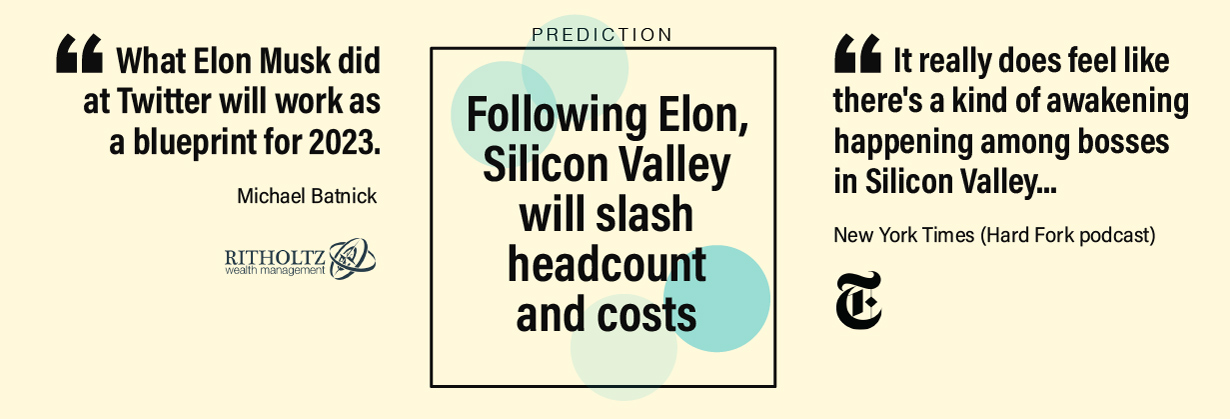
Employees in the tech industry are very well compensated, and many were hired during periods of intense competition between companies to attract talent and capture market share.
During a downturn, it’s tempting—and often necessary—for companies to course-correct. There were also predictions that the whole start-up and investment ecosystem could be switching from a hypergrowth to a value-focused mindset, which is a theme that is worth consideration in 2023.
Technology
All of the Grants Given by the U.S. CHIPS Act
Intel, TSMC, and more have received billions in subsidies from the U.S. CHIPS Act in 2024.

All of the Grants Given by the U.S. CHIPS Act
This was originally posted on our Voronoi app. Download the app for free on iOS or Android and discover incredible data-driven charts from a variety of trusted sources.
This visualization shows which companies are receiving grants from the U.S. CHIPS Act, as of April 25, 2024. The CHIPS Act is a federal statute signed into law by President Joe Biden that authorizes $280 billion in new funding to boost domestic research and manufacturing of semiconductors.
The grant amounts visualized in this graphic are intended to accelerate the production of semiconductor fabrication plants (fabs) across the United States.
Data and Company Highlights
The figures we used to create this graphic were collected from a variety of public news sources. The Semiconductor Industry Association (SIA) also maintains a tracker for CHIPS Act recipients, though at the time of writing it does not have the latest details for Micron.
| Company | Federal Grant Amount | Anticipated Investment From Company |
|---|---|---|
| 🇺🇸 Intel | $8,500,000,000 | $100,000,000,000 |
| 🇹🇼 TSMC | $6,600,000,000 | $65,000,000,000 |
| 🇰🇷 Samsung | $6,400,000,000 | $45,000,000,000 |
| 🇺🇸 Micron | $6,100,000,000 | $50,000,000,000 |
| 🇺🇸 GlobalFoundries | $1,500,000,000 | $12,000,000,000 |
| 🇺🇸 Microchip | $162,000,000 | N/A |
| 🇬🇧 BAE Systems | $35,000,000 | N/A |
BAE Systems was not included in the graphic due to size limitations
Intel’s Massive Plans
Intel is receiving the largest share of the pie, with $8.5 billion in grants (plus an additional $11 billion in government loans). This grant accounts for 22% of the CHIPS Act’s total subsidies for chip production.
From Intel’s side, the company is expected to invest $100 billion to construct new fabs in Arizona and Ohio, while modernizing and/or expanding existing fabs in Oregon and New Mexico. Intel could also claim another $25 billion in credits through the U.S. Treasury Department’s Investment Tax Credit.
TSMC Expands its U.S. Presence
TSMC, the world’s largest semiconductor foundry company, is receiving a hefty $6.6 billion to construct a new chip plant with three fabs in Arizona. The Taiwanese chipmaker is expected to invest $65 billion into the project.
The plant’s first fab will be up and running in the first half of 2025, leveraging 4 nm (nanometer) technology. According to TrendForce, the other fabs will produce chips on more advanced 3 nm and 2 nm processes.
The Latest Grant Goes to Micron
Micron, the only U.S.-based manufacturer of memory chips, is set to receive $6.1 billion in grants to support its plans of investing $50 billion through 2030. This investment will be used to construct new fabs in Idaho and New York.
-

 Energy1 week ago
Energy1 week agoThe World’s Biggest Nuclear Energy Producers
-

 Money2 weeks ago
Money2 weeks agoWhich States Have the Highest Minimum Wage in America?
-

 Technology2 weeks ago
Technology2 weeks agoRanked: Semiconductor Companies by Industry Revenue Share
-

 Markets2 weeks ago
Markets2 weeks agoRanked: The World’s Top Flight Routes, by Revenue
-

 Countries2 weeks ago
Countries2 weeks agoPopulation Projections: The World’s 6 Largest Countries in 2075
-

 Markets2 weeks ago
Markets2 weeks agoThe Top 10 States by Real GDP Growth in 2023
-

 Demographics2 weeks ago
Demographics2 weeks agoThe Smallest Gender Wage Gaps in OECD Countries
-

 United States2 weeks ago
United States2 weeks agoWhere U.S. Inflation Hit the Hardest in March 2024




